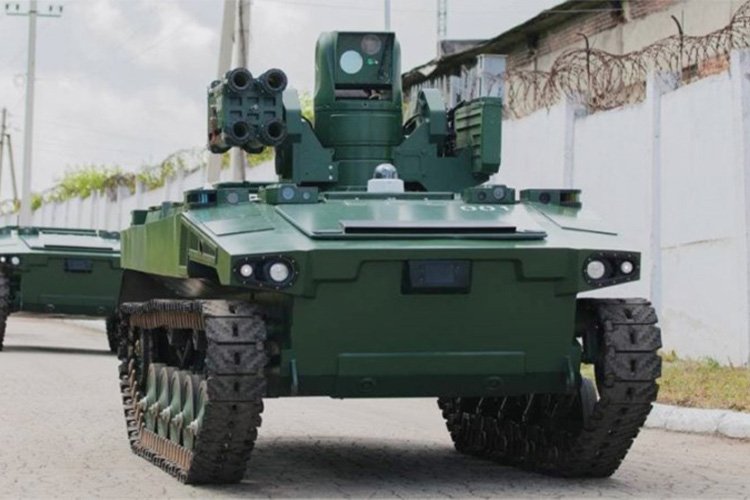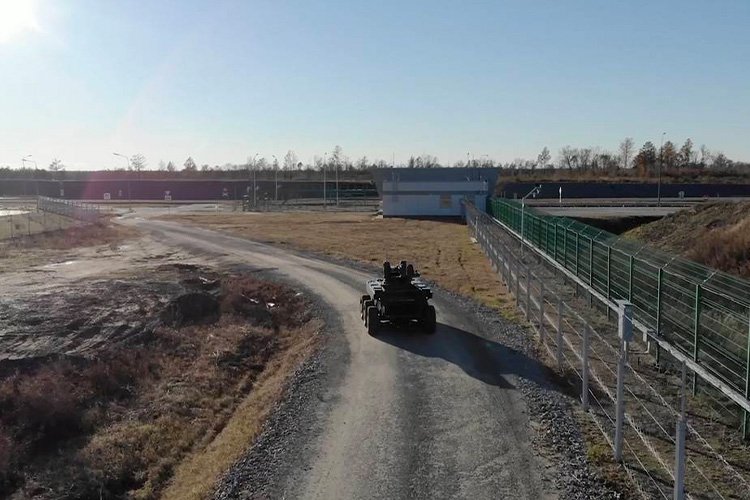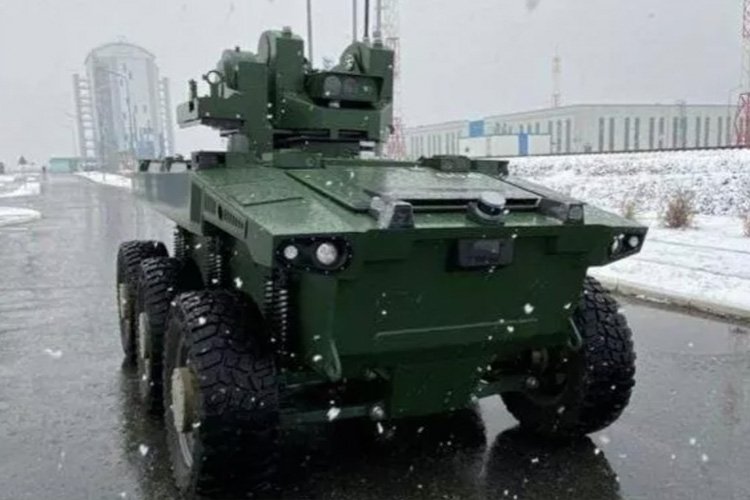This week, Russia announced plans to develop a combat version of its “Marker” robotic tank, capable of destroying advanced Western armored vehicles like the U.S. M1 Abrams, German Leopard 2, or British Challenger 2 battle tanks.
The announcement comes on the heels of news that Western allies would be donating more than 100 sophisticated tanks to Ukraine to support its ongoing defense against Russia’s invasion.
Dmitry Rogozin, the former director of Russia’s space corporation Roscosmos and current head of the “Tsar Wolves” military advisory group, announced that his team was working with the Advanced Research Foundation, a Russian analog of the U.S. Defense Advanced Research Project Agency (DARPA), and Android Technika to adapt Android’s Marker uncrewed reconnaissance vehicle into a Western tank killer.
“I spoke again with colleagues from Android Technika and the Advanced Research Foundation,” Rogozin wrote on Telegram. “Everyone agrees that our strike Marker, for the remaining time before the arrival of the Abrams and Leopards in Ukraine, should be prepared for their destruction along with the crews.”
In an interview with the Russian-state media outlet RIA Novosti, Rogozin elaborated that the combat variant of the Marker robotic tank “would be able to automatically detect and hit the ‘Abrams,’ ‘Leopard’ and other vehicles due to the electronic catalog in the control system with images of enemy equipment.”


On January 15, Rogozin similarly announced on Telegram that Marker would soon undergo a “baptism of fire in Donbas.”
According to state news agency TASS, Marker possesses “technical vision, automatic control systems,” and electronic warfare capabilities that allow the robotic tank to “autonomously” perform a variety of combat missions.
Executive director of Android Technika, Yevgeny Dudorov, described Marker as having “the most advanced autonomous driving skills in Russia, with object recognition based on artificial intelligence technologies.”
Head of the Marker project for Android Technika, Alexei Bogdanov, further claimed that the robotic tank can simultaneously strike multiple targets with different weapon systems.
“The Marker features a new system of drive solutions where an optoelectronic instrumentation unit that conducts observation, locks on, and tracks an object is in the center and has its own separate drives while the drives for mounting the payload (armaments) are located to its left and right side and operate independently in a mode unrelated to each other,” Bogdanov told TASS. “This arrangement makes it possible to simultaneously strike targets with various armaments.”
Ultimately, the ability to take on Western battle tanks is just the latest in a string of claims by Russian officials about Marker’s capabilities.
In late 2020, the Russian Ministry of Defense said Marker had completed final testing, and the uncrewed vehicle was slated to become a testbed for next-generation combat robots.
By October 2021, the Russian MoD announced Marker was now being used as a security robot to protect “vital state facilities.” Reportedly, the robotic tank was patrolling the Vostochny spaceport in Russia’s far east as part of its security testing.
A month later, in November 2021, RIA Novosti reported Marker had been upgraded to serve as a medical evacuation vehicle capable of autonomously evacuating wounded soldiers from the battlefield.
More recently, the robotic tank has also been described as a counter unmanned aerial system (cUAS) system that can detect “electronic pulses” to identify and neutralize enemy drones.


It’s up for speculation as to why the armored ground drone, supposedly operational and capable of carrying out so many diverse missions, is just now being considered for inclusion in Russia’s nearly year-long war against Ukraine.
Defense observers say the most likely reason the robotic tank isn’t already in Ukraine is that most of Marker’s claimed capabilities are pure fantasy when it comes to operating in an active combat zone.
“At this point, this sounds more PR than a realistic tactic,” Sam Bendett, an adjunct senior fellow at the Center for a New American Security and an adviser at the CNA Corporation, said on Twitter.
“Previous Marker tests – at least those made public – were against small UAVs, and these [unmanned ground vehicles, or UGVs] conducted tests for orienting in a complex space like a forest, but not an actual battlefield where multiple countermeasures are trying to destroy the vehicle,” added Bendett.”
“Moreover, Western tanks will be part of combined arms formations with aerial support like drones and UAVs, which are going to hunt for any Russian target, including the likes of Marker ground vehicles. Rogozin’s earlier claims of Marker as a recon UGV were more realistic.”
The Kremlin has a bad habit of claiming to possess sophisticated operational weapons systems, like the Su-57 5th Generation stealth fighter jet or T-14 Armata battle tank, which mysteriously never appear when Russian forces could use them the most.
Curiously, when announcing intentions to make a robotic tank destroyer, the head of the “Tsar Wolves,” Rogozin, even cited one of Russia’s wayward advanced technologies.
“The partners of the Scientific and Technical Center, ‘Tsar’s Wolves’ [and] – the designers of the private Ural engineering company ‘Android Technique’ (by the way, they are the developers of avatars, including the robot ‘Fedora’ [sic] tested on the ISS) created this unique unmanned reconnaissance and strike vehicle ‘Marker,'” wrote Rogozin.
Final Experimental Demonstration Object Research, or FEDOR, was a humanoid robot designed by Android Technika to assist astronauts and cosmonauts on the International Space Station (ISS).
In August 2019, FEDOR was sent to space to perform a series of initial experiments aboard the ISS. After making more than a dozen unsuccessful attempts to switch FEDOR on, Cosmonaut Alexei Ovchinin suggested to mission control back on earth, “Maybe I should bash it with a hammer.”
Ultimately, aside from posing for pictures, the silvery anthropomorphic robot proved to be a complete failure, and Android Technika scrapped any further plans to develop FEDOR for work on the ISS.
In a recent interview, Dudorov claimed that Western technology sanctions would not hinder the company’s ability to develop and deliver systems like the Marker robotic tank. According to the Android Technika CEO, “95%” of the electronic components necessary to produce advanced robotic systems are produced domestically.
Speaking with Defense One, Bendett said Durdrov’s assessment was “optimistic” given “the continued reliance of the Russian high-tech sector on imported components.” Bendett points out that “almost 80%” of Android Technika’s FEDOR robot was made from imported parts.
If Russia does send the robotic tanks to Ukraine, Bendett says this will likely serve as a litmus test for other weapon development projects and not because anyone believes the Marker is a capable, battle-ready system.
“It appears that most of the existing Markers, 3 out of 5, will, in fact, be tested in Ukraine and can be lost in combat,” said Bendett. “It also appears that Android Technology is actually ok with that, indicating a willingness to respond to the [Ministry of Defense] needs for improved weapons and tactics, and perhaps indicating that the company is working on other projects that can build on the Marker experience.”
Tim McMillan is a retired law enforcement executive, investigative reporter and co-founder of The Debrief. His writing typically focuses on defense, national security, and the Intelligence Community. You can follow Tim on Twitter: @LtTimMcMillan. Tim can be reached by email: tim@thedebrief.org or through encrypted email: LtTimMcMillan@protonmail.com

